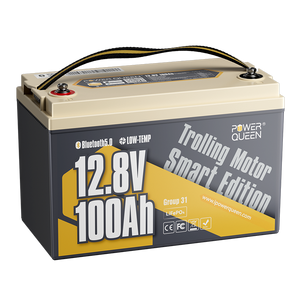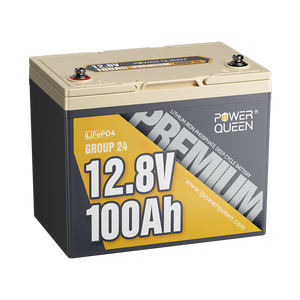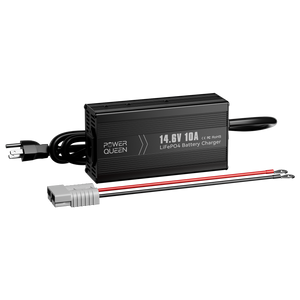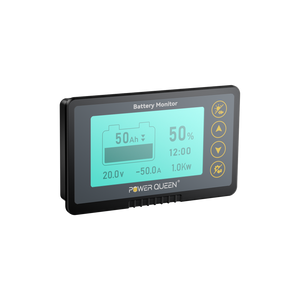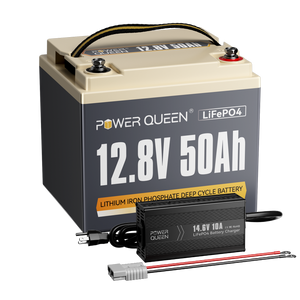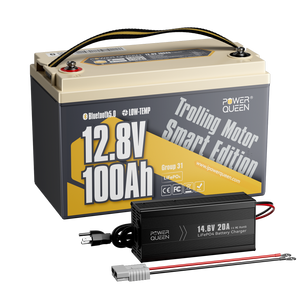How to Charge Chassis Batteries in an RV
Whether you’re preparing for a long trip, pulling batteries from storage, or dealing with the winter chill, a fully charged and well-maintained chassis battery is the key to worry-free adventures.
This guide will walk you through how RV chassis batteries work and tips for extending the life of RV chassis batteries, understanding their unique needs, and learning how to troubleshoot common problems.
Whether you’re an experienced user or a novice, this guide includes everything you need to keep your trip going smoothly and fully charged.
Table of Content
- Part 1. What are RV Chassis Batteries
- Part 2. How to Charge an RV Chassis Battery at Home
- Part 3. When to Charge an RV Chassis Battery
- Part 4. Choosing the Right Charger for Your RV Chassis Battery
- Part 5. Benefits of Using a Quality Charger
- Part 6. Tips for Extending the Life of Your RV Chassis Battery
- Part 7. Routine Maintenance Checklist
- Part 8. Common Problems and Troubleshooting
- Part 9. The Best RV Chassis Batteries on the Market
- Part 10. In Conclusion
Part 1. What are RV Chassis Batteries
The RV chassis battery is a key component that powers the RV's engine and other essential driving systems, such as the headlights, dashboard, and wipers. It is different from the home battery in your RV, which powers the living area. The chassis battery is specially designed to provide the strong and fast burst of power needed to start the engine.
Regular maintenance and proper charging are essential to keep this battery running smoothly, ensuring your RV is always ready to hit the road. This battery comes in a variety of forms, including lead-acid, AGM (absorbent glass mat), and lithium-ion, each of which offers different benefits depending on the requirements of your RV and your travel habits.
1.1 Types of RV chassis batteries
There are two main types of batteries for RVs: chassis batteries and house batteries. Chassis batteries start the engine and power the basic drive components. House batteries power the living area, supporting appliances, and lighting. Chassis batteries provide short bursts of high power.
In contrast, house batteries provide steady, long-term energy. This distinction means that chassis batteries are similar to car batteries, focusing on starting power. House batteries are similar to marine batteries or deep-cycle batteries, optimized for durability and long discharge. The main differences include capacity, discharge rate, and durability. Chassis batteries charge faster, while house batteries hold more energy for longer use.

1.2 How RV Chassis Batteries Work
Your RV chassis battery starts the engine and powers the vehicle's basic functions. It delivers a quick, powerful burst when you turn the key. Unlike a home battery, it's not designed to provide continuous power. It charges as you drive, thanks to your RV's alternator. The system converts mechanical energy into electrical energy, so keep it charged and your trip will go smoothly.
Part 2. How to Charge an RV Chassis Battery at Home
First, make sure your charger matches your battery type: lead-acid, AGM, or lithium. Next, connect the charger's red clamp to the positive terminal. Connect the black clamp to the negative terminal. Set the charger to the correct mode, such as trickle charge or full charge. Always monitor the charging process to avoid overcharging. When you're done, disconnect the charger starting with the black clamp. This method will get your RV back on the road safely and efficiently.
To charge your RV chassis battery at home, follow these steps:
- Identify Battery Type: Check if it's lead-acid, AGM, or lithium.
- Select a Charger: Use a charger compatible with your battery.
- Setup Charger: Position near the RV for easy access.
- Connect Charger: Attach the red clamp to the positive and the black clamp to the negative.
- Set Charging Mode: Choose from modes like a trickle or standard charge.
- Monitor Charging: Watch for full charge, and avoid overcharging.
- Disconnect Charger: First remove the black clamp, then the red.
- Check Battery: Ensure it's ready for your next trip.
- Using the right charger and monitoring closely ensures optimal charging.

Part 3. When to Charge an RV Chassis Battery
You should charge your RV chassis battery when you notice the following:
- Before long trips: Ensure it's fully charged.
- After idle periods: Batteries lose charge when not used.
- In cold weather: Cold can drain battery power faster.
- When the engine cranks slowly: This signals a needed boost.
Related Reading: How To Charge Trolling Motor Battery
3.1 Signs of Battery Wear
Of course, batteries wear out or become ineffective over time, and we need to replace the battery. Here are the obvious signs of RV battery wear:
- Slow cranking starts indicate reduced battery power.
- Dim lights suggest the battery is failing.
- Frequent recharges may show a battery's declining hold capacity.
- Swelling or bulging cases are serious wear indicators.
- Corrosion on terminals can hinder battery efficiency.
- Age; older batteries often wear down faster.
- Check voltage drops; significant drops signal wear.
- Unusual smells; a sulfur odor can indicate damage.
Part 4. Choosing the Right Charger for Your RV Chassis Battery
First, determine what type of battery you have: AGM, lead-acid, or lithium. Each type requires a different charger.
For the best charge and life, choose a charger designed for your battery. — They prevent overcharging by automatically shutting off. Make sure the charger's amperage is appropriate for your battery's capacity. A properly matched charger will keep your battery healthy, extend its life, and ensure you're ready for your trip.



Part 5. Benefits of Using a Quality Charger
Using a quality charger offers key benefits for your RV:
- Protects battery life: It stops overcharging, saving your battery.
- Enhances efficiency: Charges faster and uses less energy.
- Adds convenience: Many have simple plug-and-play features.
- Increases reliability: Quality chargers are durable and dependable.
- Provides versatility: They work with various battery types.
- Ensures safety: They come with built-in protections against faults.
- These features make a quality charger a wise investment for any RV owner.
Part 6. Tips for Extending the Life of Your RV Chassis Battery
Here are straightforward tips to extend your RV chassis battery life:
- Check the battery before each trip. Ensures readiness and performance.
- Charge regularly. Prevents deep discharge and prolongs battery lifespan.
- Store properly. Disconnect and keep in a cool, dry place.
- Clean terminals often. Avoids power loss and corrosion.
- Use a smart charger. Avoids overcharging and increases efficiency.
- Monitor charge levels. Helps maintain optimal battery health.
- Keep it cool. Store away from extreme temperatures.
- Inspect monthly. Catch issues early to prevent bigger problems.
- Balance charging. Ensures even wear and longevity.
- Follow the manufacturer's guidelines. Maximizes battery performance and safety.
Related Reading: How Long Do Lithium Batteries Last?
Part 7. Routine Maintenance Checklist
Here is a simple routine maintenance checklist to help you extend the life of your RV battery:
- Visual Inspection: Check for any visible signs of wear.
- Terminal Check: Make sure all connections are tight and clean.
- Voltage Check: Use a multimeter to verify voltage levels.
- Clean Terminals: Use a baking soda solution to remove corrosion.
- Distilled Water: If using a lead-acid battery, top up the fluid level.
- Secure Mounting: Make sure the battery is securely mounted.
- Check Ventilation: Verify that there is adequate airflow around the battery.
- Charge Status: Make sure the battery is fully charged.
- Find Leaks: Check for any signs of electrolyte leakage.
- Record Results: Record all inspections to see trends.
Part 8. Common Problems and Troubleshooting
Understanding common RV battery problems and how to troubleshoot them can save you time and avoid unnecessary stress during your trip. Below is a concise guide to help you effectively identify and solve typical RV battery problems.
Battery Not Holding a Charge
If your RV battery fails to hold a charge, first inspect for any signs of corrosion or loose connections, which can impede performance. Using a multimeter to test the battery's voltage can help determine if a replacement is necessary. If the voltage reads below the standard level, it’s time for a new battery.
Battery Drains Quickly
To extend battery life, avoid frequent, shallow discharges. Additionally, check for any appliances or devices that might be drawing power even when turned off. Identifying these can prevent rapid draining and extend the battery's lifespan.
Engine Starts Slowly
A slow-starting engine often points to battery issues. Ensure that the battery terminals are clean and securely connected. If the problem persists, testing the battery’s health is crucial; it might require replacement if found deficient.
Terminal Corrosion
Corrosion at the terminals can severely affect battery function. Cleaning the terminals with a mixture of baking soda and water, followed by applying anti-corrosion gel, can help mitigate this issue and prevent future corrosion.
Battery Case
Bloating of the battery case usually indicates overcharging or exposure to excessive heat. In such cases, replace the battery and ensure the charger is being used correctly to avoid similar issues.
No Power Even
After Charging If there's no power after charging, check the main fuse and the battery disconnect switch. Additionally, inspect the wiring for any breaks or disconnections that might be causing power issues.
Battery Overheating
Should the battery overheat, cease charging immediately and allow it to cool down. Afterwards, inspect for and rectify any sources of overcharging to prevent recurrence.
Battery Odor
A foul odor from the battery could signal chemical leakage and damage. In such instances, ensure the area is well-ventilated, and safely remove and dispose of the battery.
Regular cleaning and inspection of the battery can prevent many common issues. Using a smart charger helps avoid overcharging, and storing the battery in a cool, dry place during the off-season ensures longevity and readiness for use.
Read more: How To Store Electric Golf Cart For Winter
Part 9. The Best RV Chassis Batteries on the Market
If you find that your RV battery has lost its charge and it's time to replace it, here's an easy guide to help you find the right power source for your equipment, big or small.
|
Voltage |
Best for |
Benefits |
|
Small RVs |
Highly efficient, easy to install, and packs a powerful punch in a compact size. |
|
|
Mid-sized RVs |
Provides more power for a better experience, with reliable performance for longer use. |
|
|
Large RVs |
Ideal for large setups requiring strong power output and excellent durability to handle more demanding energy needs. |
|
|
Full-time RV living |
Offers top-tier energy storage and maximum efficiency, perfect for those living in their RVs and needing consistent, reliable power. |
Part 10. In Conclusion
Whether you're preparing for an epic road trip or making sure your vehicle is ready for your next getaway, it's vital to know how to care for your chassis battery.
We cover different types of batteries, when and how to charge them, and offer practical tips for extending the life of your battery. Remember, a well-maintained battery is the key to worry-free RV adventures.
Travel safely and enjoy the confidence of knowing your RV is powered by a reliably charged chassis battery. Keep this guide handy so you can always return with a full load.




